Bamboo shrimp has lots of different names. Bamboo shrimp (Atyopsis moluccensis), also known as wood shrimp or flower shrimp, are fascinating freshwater crustaceans belonging to the genus Atyopsis. Their way of feeding is their peculiarity. In this article we will tell you what kind of shrimp it is, all intricate details of how to keep it in a tank and why is called so.
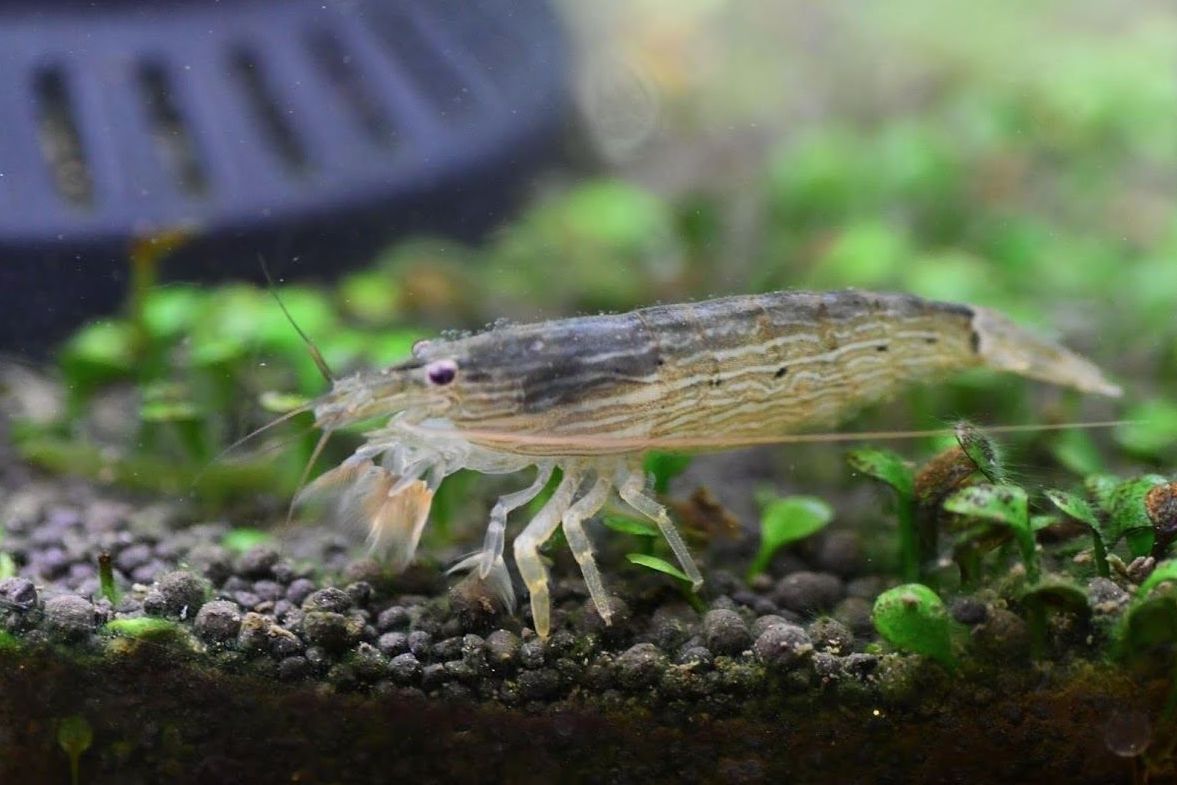
Contents
Shrimp Habitat in the wild
Bamboo shrimp comes from both Indo-Pacific region and Malaysia. They inhabit in large groups in slow rivers and streams, where they feed on various microorganisms, small particles of food. The bamboo shrimp has calm and peaceful temper which allows both settling it in a tank with small fishes and in a community tank with large fishes.
In their natural habitat, bamboo shrimp feed on suspended particles and organic matter in the water. They use their fan-like appendages to filter food particles from the water column. Algae, microorganisms, and decaying plant matter are essential food sources for them.
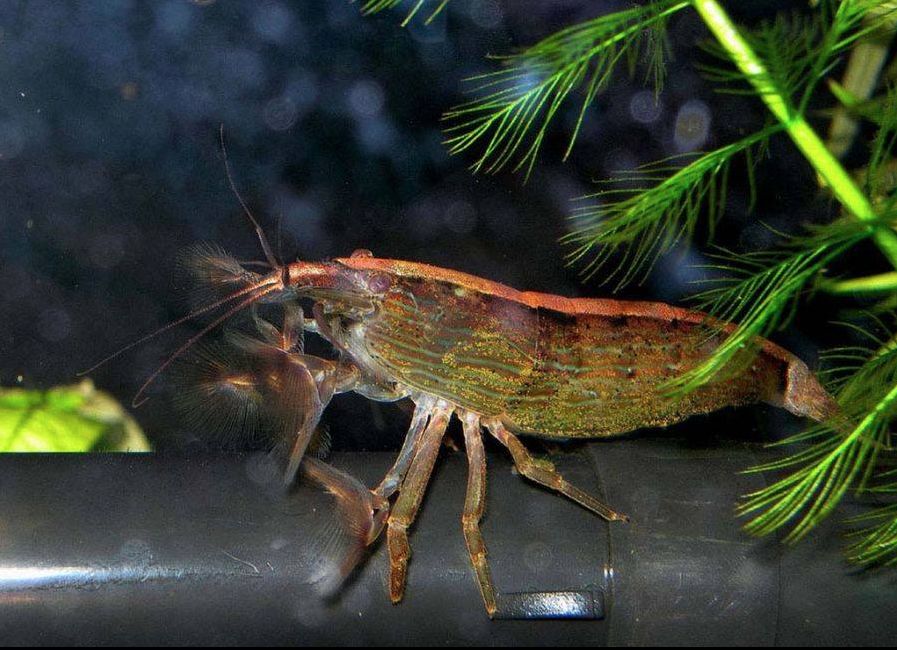
Description
You should keep in mind that commercial attractiveness of the species let to appearance of a variety of new species of bamboo shrimp. Quite often one and the same type is sold under different names. Correspondingly, these shrimps may vary significantly, since they have no classification yet. In this article you will find general description of the species and how to keep it in a tank, which is true for all breeds.
Bamboo shrimp can vary in size depending on the species. On average, bamboo shrimp typically range from 2.5 to 5 inches (6 to 13 cm) in length. However, the exact size can differ among individual shrimp and may also depend on factors such as their age and overall health.
How long do bamboo shrimp live? Bamboo shrimp lifespan is about 1-2 years or a bit longer provided with good conditions of living. However, with proper care, some individuals may live longer. It’s important to provide them with suitable water parameters, a well-established aquarium, and a proper diet to ensure their well-being and potentially extend their lifespan.
Coloring may be brown, red, sandy green or yellowish. It depends on many factors: the place where the shrimp was caught, peculiarities of its diet, shedding process, tank plants prevailing in the tank etc. That’s why it’s almost impossible to predict what color will shrimp get in a new tank. The bamboo shrimp has a white or light-yellow strip along its back.
The feature of this type of shrimps is a web-like fans as its first two pairs of legs. There are kind of hooks located on the fans that allow the shrimp to filter food from the water. The shrimp is rather large, which is necessary for it not be carried away with the water flow.
Bamboo shrimp uses its fan-shaped legs to filter water and capture microorganisms, plant remnants, algae and other small rubbish. Typically bamboo shrimps stay in the places with strong water flow, they rise their fan-like legs and filter the water. If you take a closer look, you’ll see how it shuts its fan, licks it and then opens again.
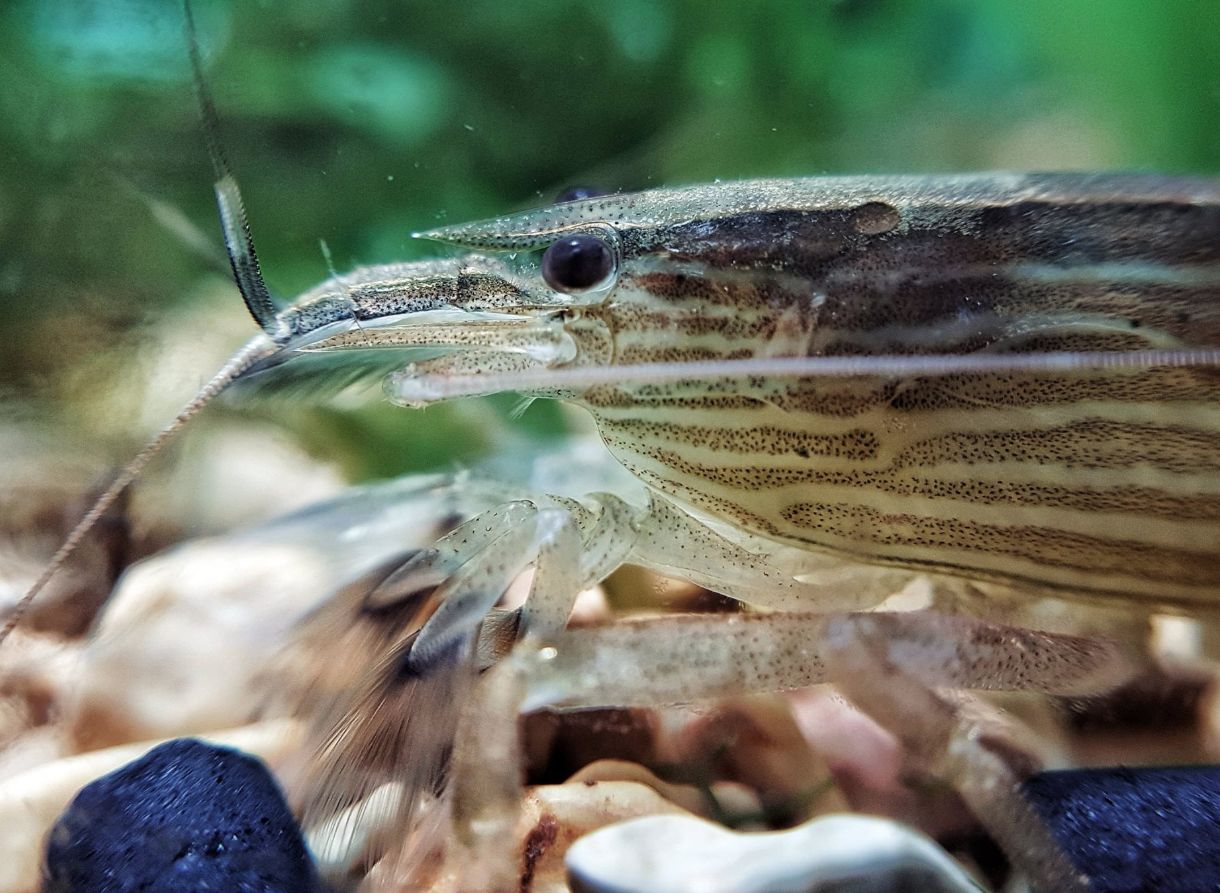
| Characteristic | Description |
|---|---|
| Scientific Name | Atyopsis spp. |
| Family | Atyidae |
| Common names | Bamboo shrimp; wood shrimp; flower shrimp |
| Size | Typically range from 2.5 to 5 inches (6 to 13 cm) |
| Lifespan | Average lifespan of 1 to 2 years, but can live longer with proper care |
| Coloration | Translucent body with various patterns and colorations, often brown or greenish |
| Body Shape | Elongated and cylindrical body shape |
| Antennae | Long, feathery antennae |
| Appendages | Have specialized appendages called fan-like maxillipeds that they use for filter-feeding |
| Filter-Feeding | Bamboo shrimp are primarily filter feeders, using their maxillipeds to capture microscopic food particles |
| Water Parameters | Prefer clean, well-oxygenated water with a pH range of 6.5-7.5 and temperature range of 72-82°F (22-28°C) |
| Tank Size | Generally, a minimum tank size of 10 gallons is recommended, with larger tanks preferred for more individuals |
| Tank Setup | Require a well-established aquarium with ample hiding places, gentle water flow, and suitable filtration |
| Compatibility | Peaceful and can be kept with other non-aggressive community fish that won’t outcompete them for food |
| Behavior | Generally sedentary and spend most of their time filter-feeding near areas with strong water flow |
| Breeding | Breeding bamboo shrimp in home aquariums is rare and challenging due to complex larval stages and specific needs |
| Care Level | Intermediate to advanced. Requires proper water parameters, regular feeding, and a suitable tank setup |
Care and Keeping in a tank
Unfortunately, many bamboo shrimps dies right after putting them into a new tank. Possibly, this happens because of stress they experience while transportation as well as new tank conditions they get exposed to.
Water parameters
Water conditions acceptable for all species are almost the same. The tank water has to be neutral or slightly alkaline (pH value about 7 or higher). As for the tank water hardness, it should be not less then 5-20 dGH.
Though it is possible to keep these shrimps in soft or even slightly acidic water. The tank requires aeration, filtration and sufficient water flow. As for ammonia and nitrites – they shouldn’t be present in a tank with bamboo shrimps. Besides, it is recommended to keep nitrates levels as low as possible – in any case it shouldn’t exceed 40 mg/l.
Tank water temperature should be within 75-81 °F (24-28 °C). It’s important to maintain a stable and consistent temperature within this range. When the temperature gets lower then 22 °C, they obviously doesn’t feel good.
Tank size
The recommended tank size for bamboo shrimp depends on the number of shrimp you plan to keep and their individual space requirements. As a general guideline, here are some recommendations:
- For a single bamboo shrimp: A minimum tank size of 10 gallons (38 liters) is suitable. This allows the shrimp enough space to move around and find suitable filter-feeding spots.
- For multiple bamboo shrimp: If you plan to keep multiple bamboo shrimp, it’s recommended to have a larger tank to provide ample space and prevent overcrowding. A tank size of 20 gallons (76 liters) or larger would be more appropriate.
Bamboo shrimp are not very active swimmers and spend most of their time filter-feeding near areas with strong water flow. Therefore, it’s more important to provide them with adequate hiding places and suitable water conditions rather than focusing solely on tank size.
In addition to tank size, it’s important to ensure the tank has a suitable setup with plenty of hiding spots, such as plants, rocks, or driftwood, as well as a gentle water flow to facilitate their filter-feeding behavior.
Tank decor
Bamboo shrimps looks very unusual in a community tank. They sit on some heights and catch water flow with their fans. Taking into account peculiarities of the feeding and behavior, we can conclude that good filtration and clean water are obligatory requirements to keep a shrimp in a tank.
Bamboo shrimp prefer areas with gentle to moderate water flow. Providing them with a gentle current helps create an optimal environment for their filter-feeding behavior.
You can use both internal and external filters, the main thing is that they provide the required water flow intensity. It is better to put stones, snags, large tank plants along the water flow. Your bamboo shrimp will sit on them like a monument and catch the food flowing by.
It is important to make sure that your shrimps don’t starve, which can easily happen considering their unusual way of feeding. The first sign indicating that your shrimps are starving is that they start spending more time on the tank bottom and move looking for some food. Because, normally, they usually sit on some high places in the tank and catch the food from the water flow.
Though it is not a small shrimp, it can hide so good that it will be hard to find it even in an empty tank. If nothing scares bamboo shrimp, they sit swaggeringly on tank plants or walk along the tank bottom looking for food.
Feeding
You can’t imagine how they enjoy the moment when you clean the tank bottom, dig out tank plants or feed the fishes with small grained food like frozen brine shrimp. They try to get closer to the center of such events.
They also becomes active when you wash your tank filter and small pieces of dirt and food fall from the filter and are carried away with the flow. Keep in mind, that very often bamboo shrimps starve in pet shops! So when they get into a new tank, they start walking along the bottom and looking for some food. This is quite common behavior for shrimps bought in a pet shop.
Therefore, be ready to feed them high at first. Bamboo shrimps should be fed with high quality dry food for tank fish. Very small grained, slowly drowning pellets for fish juveniles will be especially good.
Frozen daphnia and cyclops, live brine shrimp nauplii and decapsulated eggs of brine shrimp will do as well.
Food gravitated to the tank bottom will be easily “swept” by bamboo shrimps. Sometimes it happens that there is no suspended food in a tank and there won’t be for some period of time, but the shrimps refuse to go round the tank bottom and look for food there.
They are just sitting near the pump and filtrating the water flow to get some food (which is missing) and they may even die this way. In this case you should turn off the pump before feeding.
When the flow in the tank disappears, the bamboo shrimps will understand that the food will not come to them and they’ll start sweeping the tank bottom.
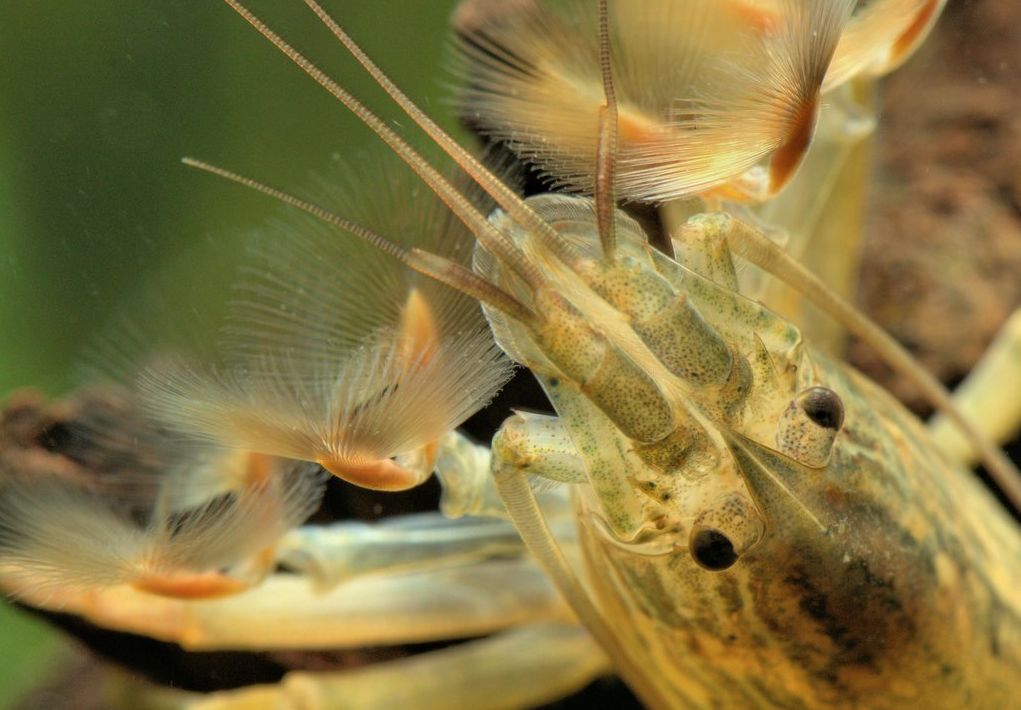
Tank mates
Bamboo shrimp has very easygoing temper and it can live in groups. However, they tend to show territory dependence in small tanks, without hurting each other though. The main thing for them in this case is to push the other shrimp from its high place and get there.
Tank mates must be peaceful and small. When considering other shrimps, you may take cherry and Amano shrimp.
The same advise concerns fish, if you choose them as tank mates. You should avoid pufferfish, most of cichlids. Bamboo shrimp is completely helpless and harmless.
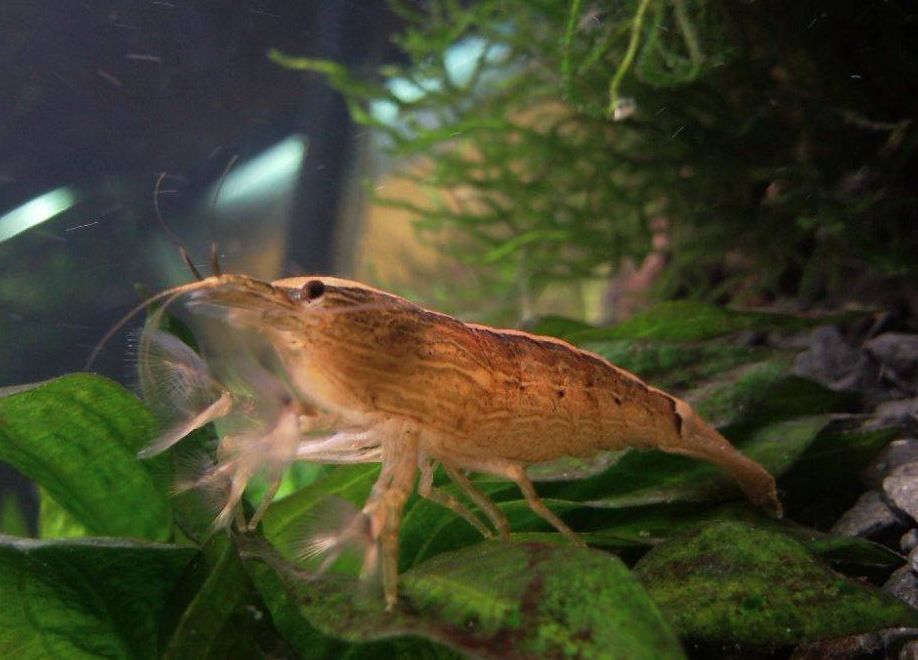
Shedding
How do shrimps grow? They shed their shin from time to time and right after shedding, when the new chitinous carapace is soft, they grow.
We should mention that for shedding process is a serious challenge. However, if tank conditions are favorable the process ends successfully.
Let me remind you, that all crustaceans have to shed occasionally. They take off their old chitinous carapace, which becomes small. They literally shed their skin, which is not easy at all. But they still manage to do it every time. Moreover, while shedding they grow new parts of the body, instead of the ones they lost.
That’s why you can take a risk and buy a bamboo shrimp with some missing limbs or antennae, which can be encountered very often in pet shops. All shrimps were taken to us from faraway warm countries and they have been through hard times while transportation and living in different tanks before getting here.
So, create comfortable tank conditions for such a shrimp and in a few month all missing parts of its body will grow again.
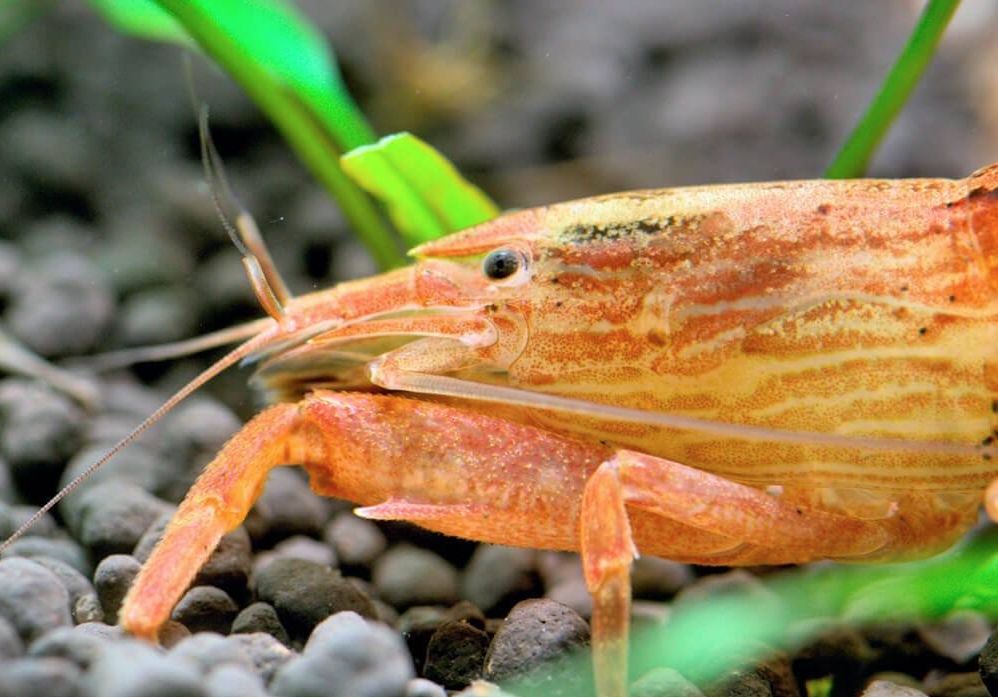
Gender differences: male vs female
Distinguishing between male and female bamboo shrimp can be challenging, as they do not display distinct physical differences. Both male and female bamboo shrimp have a similar appearance, with elongated bodies and feathery antennae. Unlike some other shrimp species, they do not exhibit prominent color or size variations between males and females.
To determine the sex of bamboo shrimp, it often requires close observation and behavioral cues.
You can see between bamboo shrimp female and male, because the female has larger abdomen and longer pleopods. Male is slimmer. Male have different first pair of limbs – they are more developed and have small claws, which they use while mating.
Breeding
Breeding bamboo shrimp in home aquariums can be challenging and is less commonly achieved compared to some other shrimp species. This is primarily due to the complex larval stages and specific environmental requirements for successful breeding.
Bamboo shrimp development cycle is rather complex and clearly indicates on estuarine or sea habitat of their ancestors. Females stick about several hundreds of small eggs (about 1.8 mm in diameter) to their pleopods and carry them for about 22 days. Small larvae which is able to swim hatches from these eggs.
But they soon die while shedding or get into the tank filter, or they are eaten by their parents, if you don’t put them away timely. The thing is that juveniles can grow successfully only in seawater or brackish water (with percentage of salt about 28 grams for 1 liter of water) and they require specialized diet: first it is phyto- and then zooplankton.
In the wild larvae are carried down the river flow fast and they get to river estuarine into brackish water. It is possible to grow the larvae in the home, but it is difficult. Without exaggeration, it will be quite a feat to feed larvae regularly and keep almost ideal hydrochemical conditions in the tank.
Sources: